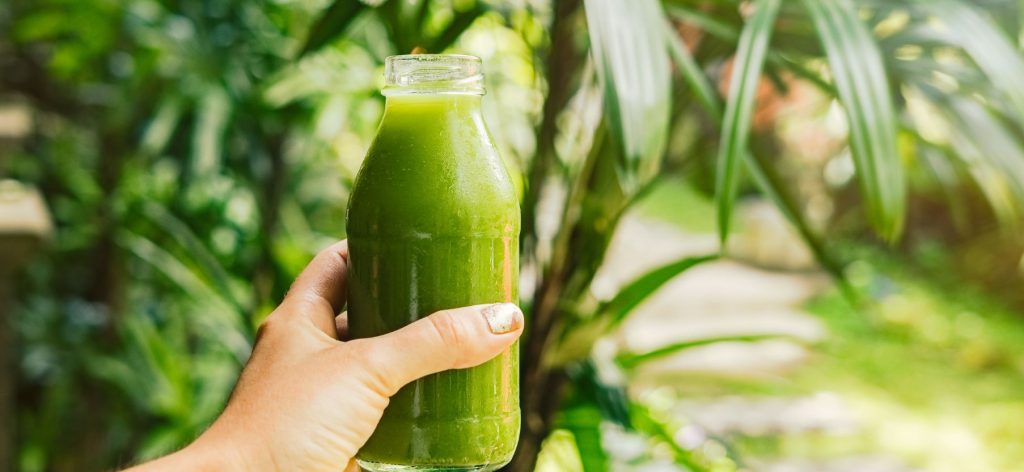Cold-pressed juice is more than just the most popular celebrity accessory since the Birkin bag. According to its proponents, it’s the healthiest, most convenient way to reap the nutritional benefits of fruits and vegetables—a combination of technical innovation and sustainable practices that make healthy consumption more accessible than ever. The science backing up the buzz is still a work-in-progress, but brands are finding new ways to produce cold-pressed juice that maximizes its beneficial properties and assuages doubters.
The cold, juicy truth
Cold-pressing juice refers to a process by which juice is extracted using hydraulic pressure at low temperatures. The pressure is important because traditional centrifugal and masticating juicers damage the cellular structure of produce as they pulp it, and the low temperature is important because the heat and oxidation that occurs with those traditional methods additionally saps the juice of its antioxidants and digestive enzymes. With cold-pressed juice, more of the original plant’s cellular stability remains intact, along with the vitamins and minerals that make them so healthy.

Sounds simple, right? Not exactly. Producing, storing, and distributing cold-pressed juice presents its own challenges. As Hana James, co-founder of Toronto-based Greenhouse, describes: “The benefits of cold-pressed juice are impacted by the condition of the process, types of fruits and vegetables used, and storage conditions. We process in a very cold environment, to keep the nutrients as high as we can.” These low temperatures not only have to be maintained where the juice is being produced but also while the juice is bottled, packaged and “all throughout the supply chain.”
And once cold-pressed juice is bottled and ready to buy, there’s still an additional layer of complexity created by its extremely short shelf-life. A recent study indicated that cold-pressed juice starts to lose some of its antioxidant capacity and physicochemical properties in a matter of days, which means inventory management and timely distribution is key. Jeff Tumbach, co-founder of Calgary-based Well Juices, says that “a 3-day shelf is significantly shorter than almost any other product in the grocery store. It’s a standard we have to set for ourselves to deliver fresh, healthy products, and it’s really helped us hone our craft as we’ve grown. With our HPP (high pressure processing) technology, we have managed to extend that 3-day shelf life to 100 days.”

Raw and unfiltered
Cold-pressed juice, unlike the cartons you’ll find on grocery store shelves, is unpasteurized. This is because pasteurization involves applying high heat to food products (most commonly eggs and dairy, but it’s applied to a host of others) for a short time in order to kill potentially harmful bacteria (whether pasteurization is really necessary in this day and age is another topic up for debate). Of course, as we’ve talked about, it’s the “cold” part of cold-pressed juice that gives it its nutritional density and rich flavour profile. Subjecting it to the heat of the pasteurization process would undo all of that.
There are a few ways to solve this dilemma. Greenhouse developed a process they call light filtration, which uses low temperature ultraviolet rays to filter out harmful pathogens. This reduction in micro-organisms (a 100,000X reduction, to be exact) helps protect, in James’ words, “against all food-borne pathogens, natural microbiota, molds, yeasts, with minimum impact on quality and nutritional attributes.” Greenhouse are understandably proud of their innovation (not least because it allows them to bottle their juices in reusable, glass bottles) and go into detail on how it works on their website.

Well Juice has taken a different approach. They use High Pressure Process (HPP), where extracted juice is subjected to (heat-free) pressurization of nearly 87,000 PSI, enough to eliminate bacteria and microorganisms without losing any of those delicate nutrients and flavours. Trumbach describes it as being akin to a “2nd cold press process”. Well invested in HPPs technology early on, having seen it at work in large-scale juice manufacturers in the U.S. They’re now the only company in Canada who own and operate their own HPP facilities, and the extended shelf-life it’s given their products has allowed it to stock grocery shelves nationally confident that they’re delivering a fresh product.
Fruit of knowledge
The claims cold-pressed juice brands make about freshness, shelf life, nutritional value…it’s all backed up by science, even if that science isn’t a settled question. Studies have come to conflicting conclusions as to whether cold-pressed juice has an nutritional advantage over traditional juicing, or whether the non-thermal treatment processes companies like Greenhouse and Well employ offer superior product stability. But research is still patchwork and inconclusive. Both Greenhouse and Well rely on their own research and development to improve their products, and James believes this will lead to more relevant results:
“At the academic level, the volume of the data is limited to tens of experiments, while at the commercial level the studies are massive and the experiments are happening in real production conditions. So the obtained results are much closer to real life.”
Regardless of the pace at which the research moves, cold-pressed juice offers a solution for those who want to optimize their diet with a product that is sustainably and mindfully made, with local ingredients and transparent manufacturing. The finer points of the chemistry are an ongoing debate, but the health benefits are intuitive and obvious.

